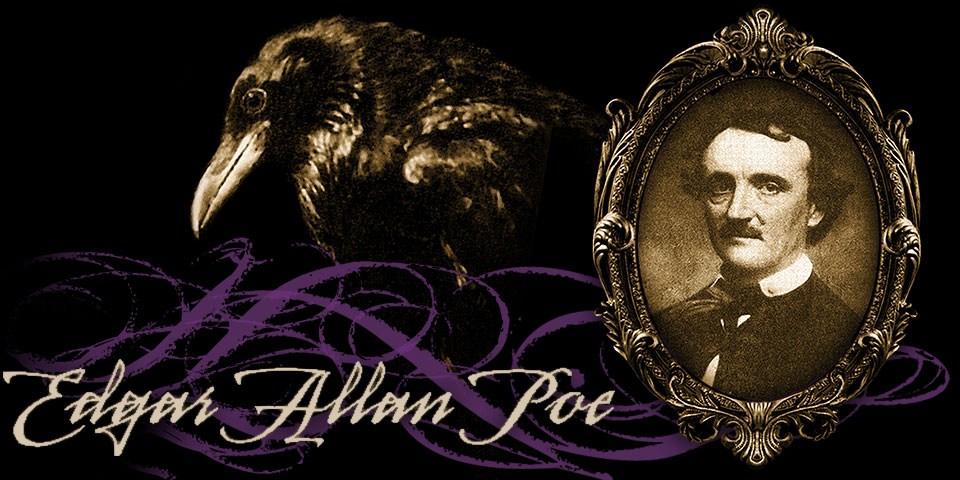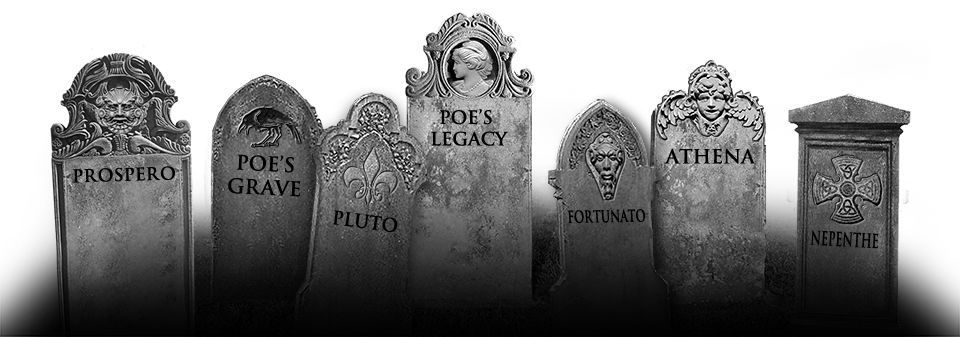The Early Years
Edgar Allan Poe (1809-1849) created a literary legacy of tragedy and gloom that mirrored the actual events of his life. Orphaned at the age of two, young Edgar was taken in by friends of his mother, John and Fanny Allan, although Edgar was never officially adopted by them. The Allans moved to London, where Edgar began his formal education, but returned to Richmond, Virginia after five years. When he was of age, Edgar joined the Army and entered West Point Academy. While he was there, Fanny Allan died and his relationship with his foster father deteriorated, until John Allan ceased all contact with Edgar. Soon afterward, he was dismissed from the Army for several counts of insubordination. Once the stability of his young life had been torn apart, Poe decided to follow his lifelong passion and pursue a career as a professional writer.
Though several of Poe's early works were published, none of them garnered him much recognition in the literary world. In 1845, Poe's poem "The Raven" was first published in the New York newspaper The Evening Mirror. The poem was hailed by critics as a work of genius, earning Poe a respected reputation as a serious writer.
In Poe's fictional world, cats could incite a man to unfathomable loathing and violence, vengeful dwarves could literally make monkeys out of kings, and the dead rarely if ever stayed dead. "The Tell-Tale Heart," in which the imagined beating of a murder victim's heart unnerves the murderer enough to make him confess his crime, is perhaps the definitive tale of psychosis and guilty conscience. There is no more memorable study of icy, calculated revenge than "The Cask of Amontillado," in which a character is bricked up alive in a wine cellar. And the eerie, fable-like "The Masque of the Red Death" is probably the quintessential horror story; in it, a rich, haughty prince's masquerade ball in a time of plague is not immune from the menace of the Red Death, for it arrives as the ultimate uninvited guest.
While he pioneered the depiction of horror and madness, he also originated the detective story, in which heightened powers of reason and deduction solve bewildering mysteries. "The Murders in the Rue Morgue" and "The Mystery of Marie Roget" were the first examples of the 'story of ratiocination,' and their influence can be felt even in modern day crime novels and police procedurals.
Reason and logical analysis were key pillars of Poe's literary life. His voluminous essays and book reviews established his name as an astute, and often harsh critic. He wrote over a dozen articles on cryptography, often challenging readers to send him ciphers which he would then easily crack. In his tale "The Gold Bug," Poe includes a crash-course on code breaking as he describes how the main characters use logic to decipher the directions to a buried pirate treasure.
However, while Poe's literary career was on the rise, his personal life was disintegrating into embarrassing chaos and irrationality.
Poe's Decline
Despite gaining much critical and popular acclaim, the economic fragility of the magazine business forced Poe to latch onto whatever periodical would have him. He took up residence in first Baltimore, then Philadelphia, then New York, wherever he could find promising work. But his often serious problem with alcohol combined with his innate combativeness as a critic and employee only succeeded in alienating one editor after another. His vicious critical attacks upon Henry Wadsworth Longfellow and other prominent writers of the time outraged the literati. Wherever Poe went, he made enemies and created hard feelings.
The spitefulness of his literary demeanor seems inextricably linked to the increasing desperation of his personal situation. He was always in need of money, not only for his sake but also for the sake of his young wife, Virginia, who was dying of tuberculosis.
His first cousin on his father's side, Virginia Clemm married Poe when she was only thirteen. He found her childlike innocence and beauty enchanting, and she in turn was devoted to him; their relationship seemed more like that of brother and sister than husband and wife. As his professional life grew more perilous, Virginia became more and more his only source of joy. In a letter to her, he writes, "You are my greatest and only stimulus now, to battle with this uncongenial, unsatisfactory and ungrateful life."
On January 30, 1847, that stimulus was removed for good. Virginia was only twenty-five when she died.
Poe had lived with the fact of her inevitable death for years, and it haunts his work. The Red Death is a thinly veiled tuberculosis scourge. In "The Oblong Box," a grieving artist lashes himself to the coffin of his dead wife as the ship carrying them both is wrecked by a storm. And despite his claims to the contrary, "The Raven" can be seen as a rehearsal of his own forthcoming grief.
A Tragic End
On October 3, 1849, forty-year-old Edgar Allan Poe arrived in a Baltimore tavern, barely conscious and clad in filthy, ill-fitting clothes that probably were not his. Ostensibly in town to drum up subscribers for a potential literary magazine, he was found at the tavern by an acquaintance who became alarmed by Poe's wrecked, incoherent state. The renowned author of "The Raven" was taken to nearby Washington Medical College, where his condition worsened. Miserable and delirious, Poe spoke to imagined people, and in one grimly lucid moment told a doctor that the best thing that anyone could do for him would be to put him out of his misery with a pistol.
Poe spent the next few days in the hospital, semi-conscious and raving, suffering from either severe alcohol poisoning or some form of encephalitis. Then, on the morning of October 7, his delirium abated, and the attending doctor heard him utter his last words: "Lord, help my poor soul." With that, the brief, unhappy life of Edgar Allan Poe was over.
No one knows how Poe ended up in Baltimore in such a pitiable state, but this denouement was very much in keeping with the rest of his life. Like a character from one of his own stories, Poe struggled mightily for a life of reason and refinement, but his every step seemed haunted by specters of madness and personal chaos.
Poe's Legacy
Poe's work has earned him an enviable place in American literature. He is not only a pioneer of the short story, he's America's first major horror writer as well as the father of the detective story. His tales contain an almost timeless fairy tale-like quality; filled with grim dungeons, Gothic castles, dwarves and madmen, Poe's fictional universe still exerts a hold on the imagination more than a century after his death. American International Pictures adapted eight of his stories into films beginning in 1960, and writers as disparate as H.P. Lovecraft and Stephen King have cited Poe as a major influence on their work.
His poetry also exhibits an astounding popularity. "The Raven" is perhaps the most recognizable poem in the English language, its haunting sing-song rhythm and unforgettable imagery appealing not only to literary connoisseurs but also to school children and people who rarely read poetry. Everyone, it seems, knows the raven's cry of "Nevermore."
It is finally, then, his command of language that is his greatest bequest to posterity. From the classic opening line of "The Raven," to the ornate description of the decaying House of Usher, Poe's diction is often elevated and complex, but it could also be blunt and fragmented. Poe was a deliberate, precise wordsmith who labored over the placement of every dash and comma. Like Shakespeare, he could transcend the sordidness of his subject matter by the sheer force of his language.
Poe was not the first Gothic writer but he is undeniably one of the most potent. While other horror writers come and go, his place in horror literature will remain unchanged, for it is his work that has formed a lasting foundation upon which others continue to build.
Written by Joseph Iorillo, first published in Dark Realms Magazine, Issue #8, Fall 2002


